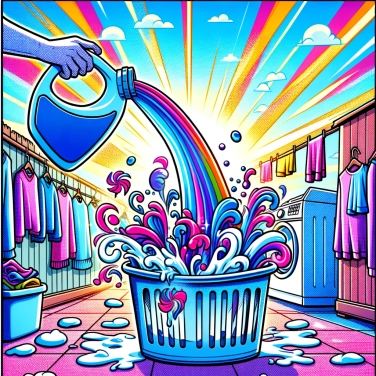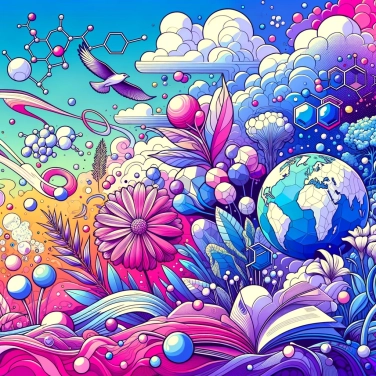Bleach contains active chlorine that reacts with colored pigments present on the fabric, breaking them down into colorless molecules, giving the appearance of whiteness.

Household bleach is mainly composed of sodium hypochlorite dissolved in water. Essentially, it is a diluted solution that contains active chlorine, the primary agent responsible for its bleaching and disinfecting power. This active chlorine is highly unstable: it constantly seeks to release oxygen, which attacks pigments, microbes, and dirt. Bleach often also contains sodium chloride (in other words, common table salt), a secondary byproduct of its manufacturing. This basic mixture generally has a high pH, often between 11 and 13, which makes it irritating to the skin if you're not careful.
Bleach releases active chlorine in solution, notably in the form of hypochlorite ions (ClO⁻). These ions chemically react through oxidation: basically, they capture the molecules that give color to fabrics (pigments and dyes) and break them down into colorless compounds. Colors disappear because their molecular structure is altered or broken. This oxidizing process is very effective, but it also weakens the fibers of the textile with repeated use.
Bleach contains an active compound, sodium hypochlorite, which breaks down the molecules responsible for colors in fabrics. These molecules, known as pigments or dyes, have a precise chemical structure that absorbs and reflects light. Hypochlorite quickly attacks their chemical structure. As a result, these molecules degrade and lose their ability to absorb visible light. The color then disappears visually, and the fabric becomes lighter or even completely discolored. It's ideal for tough stains, but it doesn't hold back: leave your laundry too long in bleach and voila, welcome to the faded clothes team!
Bleach is super effective, but it remains a chemical that should be handled with care. It can cause serious burns on the skin and severe irritation of the eyes. Breathing in its fumes poses a risk of respiratory problems such as a persistent cough or even more serious issues. Absolutely to be avoided: mixing bleach with vinegar or other acidic cleaners, as it releases highly dangerous toxic gases, including the infamous chlorine gas. Gloves, protective goggles, and adequate ventilation are not a luxury; they are the bare minimum when engaging in intensive cleaning with this product. It's also good to know: properly dilute the solution to limit risks, and above all, keep the bottle out of reach of children.
Baking soda is clearly a star among natural products: it removes stains, neutralizes bad odors, and brightens laundry. When combined with white vinegar, it boosts its effectiveness even more. Lemon juice also works well, with its natural citric acid that helps remove stains and revive white fabrics. Drying in the sun further enhances its whitening action. Hydrogen peroxide is also a good alternative if you're looking to whiten and disinfect your clothes without harsh chemicals. In short, there's no need for harsh chemistry; simple tips are often enough to achieve impeccable whiteness.
The sunlight also has a natural ability to whiten fabrics thanks to its ultraviolet rays, making it an eco-friendly alternative to consider for your delicate textiles.
Even though it is very effective for whitening, bleach does not actually clean dirt. It disinfects, oxidizes unwanted dyes, and masks stains without necessarily removing them.
Mixing bleach with vinegar or products containing ammonia can produce toxic gases that are dangerous to health, such as chlorine gas or chloramines.
Prolonged or repeated exposure to bleach can weaken textile fibers, thereby reducing the lifespan of your clothing and household linens.
Yes, several natural solutions such as baking soda, white vinegar, lemon juice, or sodium percarbonate provide an effective whitening action without the risks associated with bleach.
No, mixing bleach with certain products (such as acids, vinegar, or ammonia) causes dangerous chemical reactions that release toxic gases like chlorine.
No, but its excessive or frequent use can damage certain textile fibers, weaken fabrics, and cause yellowing on delicate textiles. It is advisable to always perform a test on a discreet part of the fabric beforehand.
In general, avoid using bleach on colored textiles. It works by destroying or altering the colored pigments of the clothes, thereby causing irreversible discoloration.
To neutralize bleach after using it on a fabric, rinse the textile thoroughly with clear water, then immerse it in a bath containing baking soda or diluted hydrogen peroxide. Next, proceed with another careful rinse to remove any chemical residues.

No one has answered this quiz yet, be the first!' :-)
Question 1/5